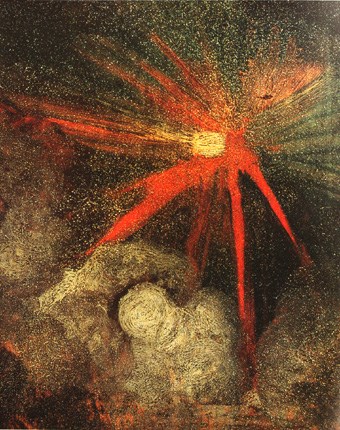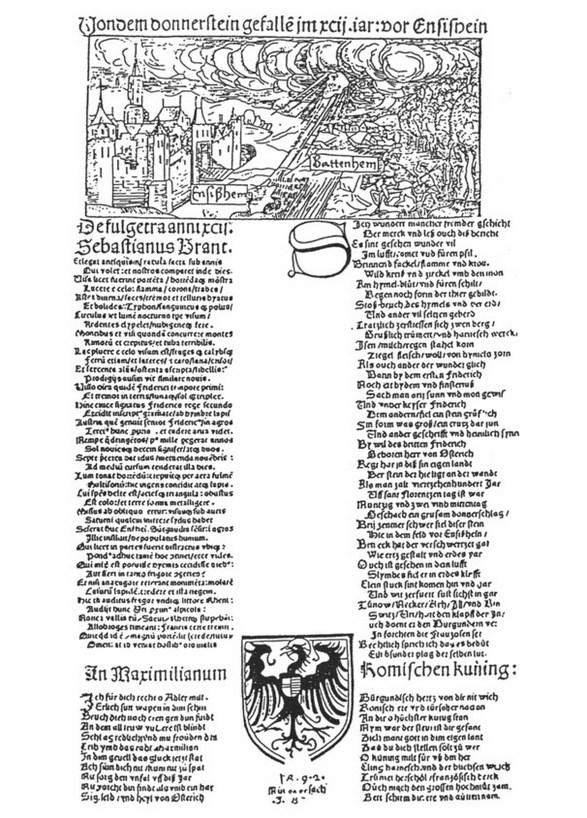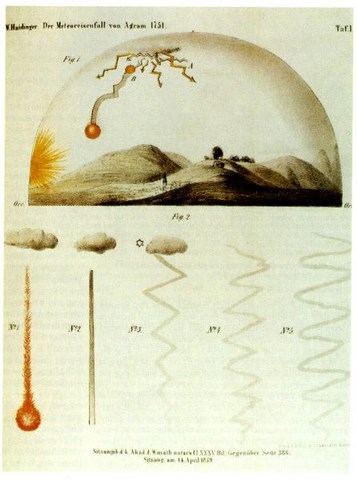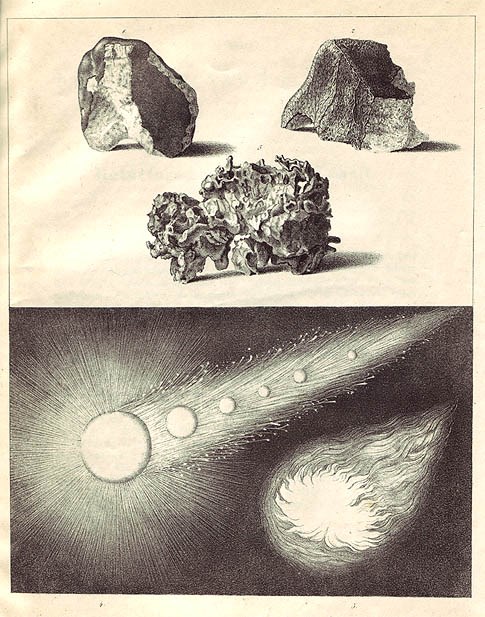Stones Falling from Heaven
A Short Historical Survey, by Anne-Marie de Grazia
Reports about "stones falling from heaven" must have existed since earliest mankind. In the late 16th century, Indians of the Chaco in Northern Argentina knew of a large mass of iron which had fallen from the sky in a place which they still called Piguem Nonralta ("Field of the Sky"), which the Spanish colonialists translated aptly as "Campo de Cielo." In 1576, a Spanish governor from Paraguay sent an expedition in search of a deposit of iron, which the Indians were said to be using to make weapons. A large mass of metal protruding out of the soil was found, said by the Indians to be of celestial origin, and samples of which were taken, to be deposited, along with the records of the expedition, in the Archivo General de Indias in Seville. The area was investigated again by Spanish explorers two centuries later and the iron deemed to have formed in a volcanic eruption. Samples from these latter expeditions were sent to the Royal Society of London. It is not until the 20th. Century that the iron masses of Campo de Cielo were identified as meteoritic - and a huge meteorite it had been, adding up to close to 100 tons of matter, distributed over 26 still identifiable craters. The event, the memory of which had been preserved by the Indians, down to their toponymy, was dated back to some 4,000 to 5,000 years...
Among the earliest meteoritic events having come down to us from our own Antiquity is the fall of a stone in Phrygia, near the city of Pessinus (120 km SW of today's Ankara), around 470 B.C. This "Phrygian Stone," which was cone-shaped, was worshipped in connexion with the Great Mother Goddess Cybele. During the Punic wars, after an impressive rain of stones over Rome, the Roman Senate consulted the Oracle at Delphi which recommended that the "Mother Stone" of Pessinus be brought to Rome. It was secured as a loan from Attalus 1st, king of Pergamon, and brought in a lavish procession to Rome in 204 B.C., where it was kept on the Palatine Hill and continued to be worshipped under the name of Mater Deum Magna Idaea, over the following centuries, as told by Plutarch (ca 46-120 AD). The loan was never returned.
Among reports from Greco-Roman Antiquity, we notice a stone "the size of a cartload" which is reported to have fallen in 467 B.C. in Aegos Potamos in Thrace, and was kept and worshipped there for many centuries. There are reports that a comet was visible in the sky at the time of the fall. It seems that the philosopher Anaxagoras got himself into serious trouble in connection with the event, for describing all heavenly bodies as being mere stones, a sacrilege for which he was beset by an irate mob. Pericles intervened - physically - to protect him. Anaxagoras was said, several centuries later, to have predicted the fall of the meteorite, which is unlikely.
The naturalist and statesman Pliny the Elder reports that he was himself the witness of the fall of a meteorite in 70 A.D., when he was procurator in Narbonensian Gaul.
The Chinese historian Ma Duanlin (1245-1325) compiled reports of meteorite falls in China covering 2000 years. A 20th Century analysis of early Chinese reports found 337 well-observed meteorite falls between 700 B.C. and 1920 A.D.
On May 19, 861, a stone of 472g fell, "among thunder and lightning" within the precinct of the Shinto temple of Nogata, on the Japanese island of Kyushu. It has been preserved inside the temple, in a casket bearing the date of impact, which has been corroborated by Carbon-14 dating of the material of the casket.
The Haschar al-Aswad, a black stone masoned into the Kaaba, the holiest shrine of Islam, is said to be a meteoritic stone retrieved from the mountains around Mekka, although its meteoritic nature has not been scientifically ascertained.
The science of meteoritic phenomena in the Middle-East was advanced enough for the Persian physicist and philosopher Avicenna (ca 980-1037) to write that "stones falling from heaven are of two kinds:" some are of the nature of stone, and some are made of iron. It would take almost 800 years for the West to catch up with this simple knowledge.
With the advent of Christianity, the numerous meteorites which had served as objects of worship were banned, discarded and destroyed. Besides identifiying the meteorites as hateful pagan objects, the Church had largely adopted the teachings of Aristotle, for whom the universe was constituted of nestled spheres, of an immutable nature, which revolved in perfect order around the Earth and could contain no stray elements of a foreign constitution or motion. There was a sphere of fire above Earth, separated from it by a sphere of air, and meteorites were thought to be fires from earth ascending to heaven to rejoin with the fire above.
In Europe, the first recorded meteorite of which some remains subsist to these days, fell around 1400 in Elbogen, in Bohemia. The exact date is not known.
A true historic sensation was created by the event which occurred at Ensisheim, in Alsace, on November 7th, 1492 just before noon (Columbus had discovered America the month before): a blazing fire-ball was widely witnessed over Switzerland and Southwest Germany and a 127 kg stone fell in a wheat field outside the town of Ensisheim. The locals rushed to the spot and eagerly started to break off pieces for use as talismans. This was soon forbidden. Maximilian of Habsburg, German King and King of the Romans, not yet Holy Roman Emperor, who was on the war-path against the French King Charles VIII. (in order to retake the King's fiancée, the 13-year old Anne of Bretagne, to whom he, Maximilian, had been married by proxy) happened to be in the vicinity, visited the impact site, and wasted no time using the event for political propaganda. He had the meteorite put into chains and hung out of reach in the church of Ensisheim.
Forty kilometers to the South, in the city of Basel, young Albrecht Dürer almost certainly witnessed the fire-ball exploding in the atmosphere and recorded his impression in an extraordinarily vivid, truly "modern" painting on the wooden back of another painting.
Also remarkably, within two weeks, several wood-cuts were made in Basel relating the event, complete with texts by the humanist Sebastian Brandt who was then teaching at the University (his Ship of Fools would appear two years later) and were printed as "flying leaves," which were distributed and sold within days all over the German speaking areas of Europe. These two events - Columbus' landing and the invention of the "sensational" press - mark October/November 1492 as the true beginning of Modernity.
The Church continued to hold on to the Aristotelian view and the Ensisheim meteorite was categorized as a miracle. Science freed itself only slowly, over the next three centuries, from this double ideological clutch. Newton's conception of the space between the heavenly bodies as being free of all matter, pervaded only by the ether, left no room for small objects, such as stones falling from the sky.
In 1771, Goethe paid a visit to the Ensisheim meteorite and chided peoples' credulity: with all the stones to be found around in the fields, why would anyone need to explain some of them as having fallen from the sky? The French Revolution sequestrated the Ensisheim meteorite as Church property. Scientific consultants accompanying the liberating American armies in 1945 tried to purchase it, but were turned down by municipal authorities. The meteorite is today on display at the town hall.

An exploding fire-ball, as seen by Albrecht Dürer - painted on the back of Saint Jerome penitent, Fitzwilliam Museeum, Cambridge University.

Flying sheet about the Ensisheim meteorite by Sebastian Brandt, printed by J. Von Olpe, Basel
(with his motto: Nüt On Ursach - Nihil Sine Causa, dated 1492)
On September 16th, 1753, a meteorite fell in Luponnas, France, and the event was studied by the astronomer Jérôme-François de Lalande (who had just achieved the first precise calculation of the distance between the Earth and the Moon). He suggested a possibly celestial origin, but his report was met with skepticism.
On September 13, 1768, at 4:30pm, workers in a field observed the fall of a meteorite in the village of Lucé, in Maine, near the road leading to Le Mans. The local priest communicated their story, together with a sample of the stone, to the French Academy of Sciences. In 1777, the sample was submitted to a chemical analysis by the latest methods - the first ever for a meteoritic stone - by the chemists Fougerous de Bondaroy, and Cadet de Gassicourt, under the direction of Antoine-Laurent de Lavoisier himself. The results were published in the Journal de Physique. The authors concluded that the stone was of terrestrial origin and could have been caused by a stroke of lightning hitting sandstone.
In 1749, in Siberia, between Ababansk and Krasnojarsk, a Cossack smith came across a mass of iron of ca 687 kg, of an extraordinary aspect, which was in the possession of a local Tatar tribe. He had it brought to his smithy. Its existence was signalled in 1776 to the German naturalist Peter Simon Pallas (1741-1811) who was on a mission of exploration in Siberia commissioned by Catherine II. Pallas was impressed. The object was made of very large crystals of peridot joined by a matrix of mixed iron and nickel. Nothing resembling it was known. He had it transported to Saint-Petersburg, where it found its way into the prestigious cabinet of curiosities which had been created by Peter the Great. Pallas returned to Berlin, bringing with him a piece of the mysterious object. (Meteorites of this very rare type would be called after him pallasites. In a strange twist, such a meteorite, weighing 198 kg, was found in 1990 near the city of Pallasovka, near Volgograd, a settlement which had been named in 1907 in honor of the German naturalist, at a distance of 4000 km from the site of his original find of the first pallasite.)
Enters a young German genius of the Enlightenment, Ernst Chladni (1756-1827). Having satisfied his father by becoming a Doctor in Law, he decided to indulge his talents in music and mathematics and turned to experimental acoustics, which he almost immediately revolutionized through the discovery of the Kladnische Klangfiguren ("Kladni Patterns") which are predictable geometric patterns created by sand on a metal sheet set vibrating with the help of a bow or a tuning fork. In 1792, during a visit to his friend, the physicist Georg Christoph Lichtenberg (1742-1799) at the University of Göttingen, he found himself exposed to intense discussions on the subject of fire-balls and meteorites, including mentions of the Pallas stone; Lichtenberg himself had witnessed a fire-ball the year before. Over the following year, as a sideline, Chladni threw himself enthusiastically into the study of all the stories of meteorite falls and of all the so-called meteoritic samples then available.
In 1794, he published the results of his work: Über den Ursprung der von Pallas gefundenen und anderer ihr ähnlichen Eisenmassen und über einige damit in Verbindung stehende Naturerscheinungen. ("About the origin of the iron masses discovered by Pallas and of similar ones, and about certain natural spectacles which are connected with them.") He argued against the various explanations hitherto offered by science as to the origin of these phenomena. He strove to establish that the phenomena of fireballs and meteorites were linked. He hypothesized that both originated outside Earth; that fireballs were created by the heat resulting from the friction of bodies entering the atmophere. He suggested that meteorites were small masses of matter moving through space before being captured by Earth's gravity field; that they were either residues of the formation processes of larger celestial bodies, or debris resulting from the destruction of such. Chladni got pretty much everything right...
Yet, Chladni's work and speculations were not received by the scientific establishment as he had hoped they would. Goethe and von Humboldt dismissed him. Lichtenberg himself was skeptical, especially as two of his students, Benzenberg and Brandes, had just carried on measurements proving that meteorites were of purely atmospheric origin; but he conceded that Chladni might still be proven right. The French Academy, of whose opinion Chladni was most hopeful, derided him. One member is said to have worried that one of those stones Chladni wrote about may have landed on his head! He found a more open mind in Sir Joseph Banks (1743-1820), President of the Royal Society in London.
That same year - 1794 - on June 16th, around 7:00pm, a dark cloud approached Siena, in Italy, broke out in a display of red lightning, followed by a tremendous explosion, after which some 200 stones, some weighing 1.5 kg, rained onto the outskirts of the city. English tourists collected some samples. Italian scientists published a study by year's end. William Thomson, of England, published the first mineral description of one of these stones, and stressed that it differed from any known rock of earthly origin.
On December 13, 1795, a field worker witnessed the fall of a 25kg stone near Wold Cottage, in Yorkshire, on the land of Major Edward Topham, a newspaper owner, who saw to it that the event was well covered. The stone was exhibited at Piccadilly. Like the stones of Siena, it was covered with a black crust. Sir Joseph Banks asked a young chemist, Edward Charles Howard (1774-1816) to undertake some analyses, together with a French émigré mineralogist, Count Jacques-Louis de Bournon (1751-1825). He added to the collection a few more samples: one from Campo de Cielo (see above); one from Agram (i.e. Zagreb) in Croatia, which had fallen in 1751; one which had fallen in Benares, India, in 1798, as well as a sample from the Pallas object. A remarkable similitude was found by the chemists to exist between the "stone-like" meteorites found on sites extremely distant from each other, as far as their mineralogy, chemical composition and texture were concerned, while they displayed at the same time a great difference with all other known terrestrial rocks. Most significantly, a high quantity of nickel was found associated with iron both in the case of the "grains" of magnetised metal contained in the "stone-like" meteorites, and in the iron making up the iron meteorites. In 1802, Howard and de Bournon presented their report to the Royal Society and in 1803, the year 11 of the French Republic, to the French Academy, where the French chemist Nicolas Louis Vauquelin also presented the results of his own, concording, analyses of samples from an other meteoritic event, a stone which had fallen at Barbotan, in the Pyrénées.
Then, on a bright, serene day of the 6th Floreal of the same year 11 (26. April, 1803), at high noon, a fireball raced through the sky over Normandy and exploded above the town of L'Aigle...
Citizen Marais, of L'Aigle, wrote about it to a friend in Paris, Citizen Château, on May 3rd. Citizen Château gave the letter to a neighbor to read, Citizen Charles Lambotin, a student in mineralogy, asking him to alert the Academy of Sciences, which he did, most efficiently, as the letter was published in the issue of 19th Prairial (May 9th!) of the Journal des Sciences Mathématiques et Physiques de l'Institut National. Citizen Lambotin went to L'Aigle and collected numerous fragments, which he sold to collectors in Paris.
Marais' letter started thus: "There has just happened in our area a rather surprising miracle..." Bonaparte, possibly alerted by the Journal, asked the Minister of the Interior, the chemist Jean-Antoine Chaptal to clarify the matter urgently, especially in view of the spectacular progress that was being made in England at the time - witness the conference of Howard and de Bournon. Chaptal sent one brilliant subject, Laplace's protégé, Jean-Baptiste Biot, age 29 yet already titular of the chair for mathematical physics at the French Academy of Sciences, to investigate on the spot...

The fall of the iron meteorite of Agram (Croatia) on May 26, 1751. Taken from: Der Meteoreisenfall von Hraschina bei Agram am 26. Mai 1751, in: Sitzungsberichte der kaiserlichen Akademie der Wissenschaften, mathematisch-naturwissenschaftliche Classe, XXXV. Band, No. 11; Vienna, 1859.
Jean-Baptiste Biot delivers. His report is unimpeachable. He proves the fact that meteoritic stones fall from the sky and that they are of non-terrestrial origin.
The news go around quickly in Europe and everyone clamors for a piece of the L'Aigle meteorite. There will be no looking back.
It will take a little while longer for the new idea to cross the Atlantic, though, witness the following story taken from:
http://www.meteorlab.com/METEORLAB2001dev/metics.htm]
In the cold chill of a December morning in 1807, Judge Wheeler walked from his home in Weston, Connecticut, USA, and was surprised to see a ball of fire moving across the northern horizon. He watched as it passed to a point almost overhead where it flashed several times and disappeared.
A few moments later he heard a great noise. Thunderous and roaring, the noise grew to a frightening level. He then heard the whizzing sound of something falling. As the judge looked up, he observed a small stone strike a nearby building, bounce off, and roll onto the grass. The judge decided to contact nearby Yale University and ask that the event be investigated.
Two very skeptical professors came out to look into the matter, fully prepared to dispel the story of stones falling from the sky. The two professors conducted a lengthy investigation. They knew these stones were different from any they had ever seen and they witnessed local townspeople extracting them from holes in yards and nearby fields. Finally, the two wise professors from Yale concluded the stones must have fallen from the sky.
Eventually the story found its way to the White House in Washington, D.C. President Thomas Jefferson was a scientist as well as a statesman. When he heard this peculiar story he declared it could not be true, but his advisors insisted that the stones were observed falling from the sky and that two Yale professors investigating the incident vouched for its truth.
Thomas Jefferson, President of the United states, responded with great skepticism: "Gentlemen, I would rather believe that two Yankee professors would lie than believe that stones fall from heaven."
A.M. deG.

This illustration of a 1838 monograph by Ferdinand Keller: An die Züricher Jugend auf das Jahr 1838 (Zürich) shows at the top, left: a piece of the meteorite of L'Aigle of 1803, top right a piece of a meteorite fallen at Stannern, in Moravia,, on May 22, 1808, and top middle a piece of the meteorite shown to Pallas in 1771. The picture below represents an enormous fire-ball which appeared on July 3rd, 1762 over Saxony and Brandenburg, before exploding loudly over Potsdam. No meteoritic masses were recovered from this incident.

